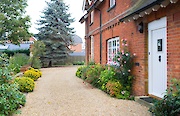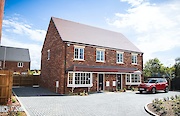


Content Writer

Mortgage Advisor & Director

When purchasing a listed building, whether a quaint Grade II cottage or a grand Grade I estate, arranging a mortgage can be complex. Although these buildings can be highly desirable, they’re also subject to strict rules. Here, we’ll explain everything you need to know about getting a mortgage on a listed building and the challenges you may face.
Can you get a mortgage on a listed building?
Yes, it is possible to get a mortgage on a listed building. But, it can be more complicated than standard properties due to a smaller pool of lenders to choose from. The specific grading of the property will usually impact how lenders assess the mortgage application:
-
Grade I listed building: These make up about 2.5% of listed properties and are considered of “exceptional interest.” Mortgages are harder to secure, with very few lending options. Often, a specialist lender or private bank is required.
-
Grade II* listed building: Around 5.8% of listed properties fall into this category and are considered “particularly important” buildings of more than special interest. Mortgages are available, but still limited, with stricter conditions and sometimes higher deposits.
-
Grade II listed building: Roughly 91.7% of listed buildings are Grade II and may include period properties with no specific historical significance, but have cultural importance due to unique Georgian, Victorian, or Edwardian architecture. Usually, mainstream mortgage lenders are more accessible, particularly if the property is in good condition and not significantly altered.
There are over 370,000 listed building entries on the National Heritage List for England (NHLE). The main reason lenders may be hesitant to let you borrow is that listed buildings carry additional risks, such as higher maintenance costs, strict rules on renovations, and possibly resale difficulties due to a smaller selection of buyers.
Which lenders offer these mortgages?
The availability of lenders depends on the grade of the property:
-
Grade I: Very few lenders will consider these, often only private banks or specialist heritage property lenders.
-
Grade II*: A limited number of mainstream lenders may let you borrow, though often at lower loan-to-value (LTV) ratios, and require specialist detailed surveys.
-
Grade II: More lenders are willing to consider these, though often still on a case-by-case basis.
Some well-known lenders that may consider lending on certain listed buildings include Nationwide, Lloyds Bank, NatWest, and Santander. Most lenders will only consider properties on their individual merits, determined by the valuer. And, there may be strict conditions or higher deposit requirements.
The best way to establish which lenders are open to a mortgage on a specific listed building is with guidance from an experienced broker. However, if you want to get an idea about current deals, you can use our free comparison tool to check interest rates from 90+ UK lenders:
Compare Rates
Showing Top Result Results
No results matching your criteria
Lender Details
Product Details
How to get a listed building mortgage
The general mortgage process is similar to any other property, but listed buildings come with unique considerations. Here’s what you’ll need to be prepared for:
-
Deposit and LTV: Expect to provide a larger deposit than for a standard property. Many lenders require at least a 15% deposit for Grade II listed buildings. Grade I or Grade II* may require higher deposits, with lower LTV limits.
-
Mortgage term length: Some lenders may cap maximum terms. For example, 25 years for older or high-maintenance listed buildings, especially if the property requires extensive work or is of non-standard construction (which can be common for period properties with unique features).
-
Affordability: Lenders will look at your income and outgoings when assessing your affordability, but they may also factor in potential ongoing costs unique to listed buildings, like specialist repairs, materials, and maintenance, which are typically more expensive.
-
Home insurance: The unique nature of these buildings means that home insurance for listed buildings is often pricier with fewer insurers to choose from. Policies may require manual underwriting and tailored terms. Lenders may request proof that you’ve secured suitable cover before approving the mortgage.
-
Surveys and valuations: For listed buildings, a standard valuation usually won’t suffice. Lenders usually require a full building survey from a surveyor with heritage property experience to highlight any current or future risks.
-
Additional documents: You may need to provide documents confirming the building’s grade, conservation restrictions, details of any work carried out or consent for past alterations.

Begin your mortgage journey
What if my Grade I property generates an income?
If your Grade I listed building generates income, the type of mortgage you need may change, depending on the nature of the revenue:
-
Holiday let or Airbnb: If you plan to rent the property on a short-term basis, you may need a mortgage designed for holiday homes or Airbnbs. Some lenders are more comfortable with Grade II listed buildings, but each property is assessed as a suitable investment.
-
Buy-to-let (BTL): If you intend to rent it long-term, a buy-to-let mortgage could be appropriate. However, many buy-to-let lenders have restrictions around listed property purchases.
-
Commercial uses: For Grade I properties, perhaps operating as hotels, wedding venues, event spaces, or something similar - a commercial mortgage may be more applicable.
This is a specialist area of lending, and the right solution depends on both the grade of the listed building and your intended use of it as an investment to generate income.
What about the rules in Scotland and Northern Ireland?
It’s worth being aware that there can be regional differences when it comes to the rules and regulations for listed buildings. Here’s an overview of what to expect across Scotland and Northern Ireland.
Listed buildings in Scotland
Scotland has more than 47,000 listed buildings and its own classification system for these properties, which broadly mirrors the English system but with different categories:
-
Category A: Outstanding examples of buildings of special architecture or historical interest for a particular period, style, or property type.
-
Category B: Major examples of buildings of special architecture or historical interest for a particular period, style, or property type.
-
Category C: Buildings of special architecture or historical interest for a particular period, style, or property type.
Mortgage implications are similar to England and Wales; the higher the grading, the rarer the property and fewer lenders are available. This often leads to more stringent surveys and insurance requirements, but it varies across lenders.
Listed buildings in Northern Ireland
There are over 9,100 listed buildings in Northern Ireland, and a slightly different grading system is used compared to other areas in the UK:
-
Grade A: Special buildings of national importance or pristine examples of an influential style or date.
-
Grade B+: Buildings that may have been a higher grade if not for minor detracting features, design flaws, or lower quality alterations.
-
Grade B1/B2: The most common, these are special buildings of local importance, and a degree of imperfection is acceptable.
Again, lenders tend to be cautious, with fewer willing to lend on Grade A properties compared to Grade B2. Local conservation rules can also impact what you can do with the property, which lenders will factor into their decision.
Why choose Teito for your listed building mortgage?
Mortgages for listed buildings work differently from standard home purchases, which is why working with a specialist mortgage broker is the best way to get the outcome you want.
Whatever your plans for your Grade I, Grade II*, or Grade II property, our brokers have plenty of experience arranging bespoke mortgage solutions for heritage homes and complex properties.
Here are some more reasons why homebuyers across the UK trust us to help them with listed building mortgages:
-
Compare current mortgage rates for listed buildings online for free
-
Our brokers are 5-star rated on leading review sites
-
Free initial chat, with no obligation to proceed further
-
Access to niche lenders who understand heritage and listed properties
If you’d like to compare the latest rates or speak with an experienced advisor about getting a mortgage on a listed building, you can get started here.
FAQs
Yes, Grade II is the most common and generally the easiest type of listed property to secure a mortgage for, though lenders may still require higher deposits and stricter terms, and more detailed surveys.
Choosing an Adviser
Selecting a qualified and experienced mortgage adviser is of great importance. To choose a suitable adviser, evaluate their qualifications, experience, and reputation, and ensure they are regulated by the Financial Conduct Authority (FCA).
Read reviews from previous clients and make sure they provide a clear explanation of the products and services they offer, as well as the fees and charges associated with them.





















































































































































